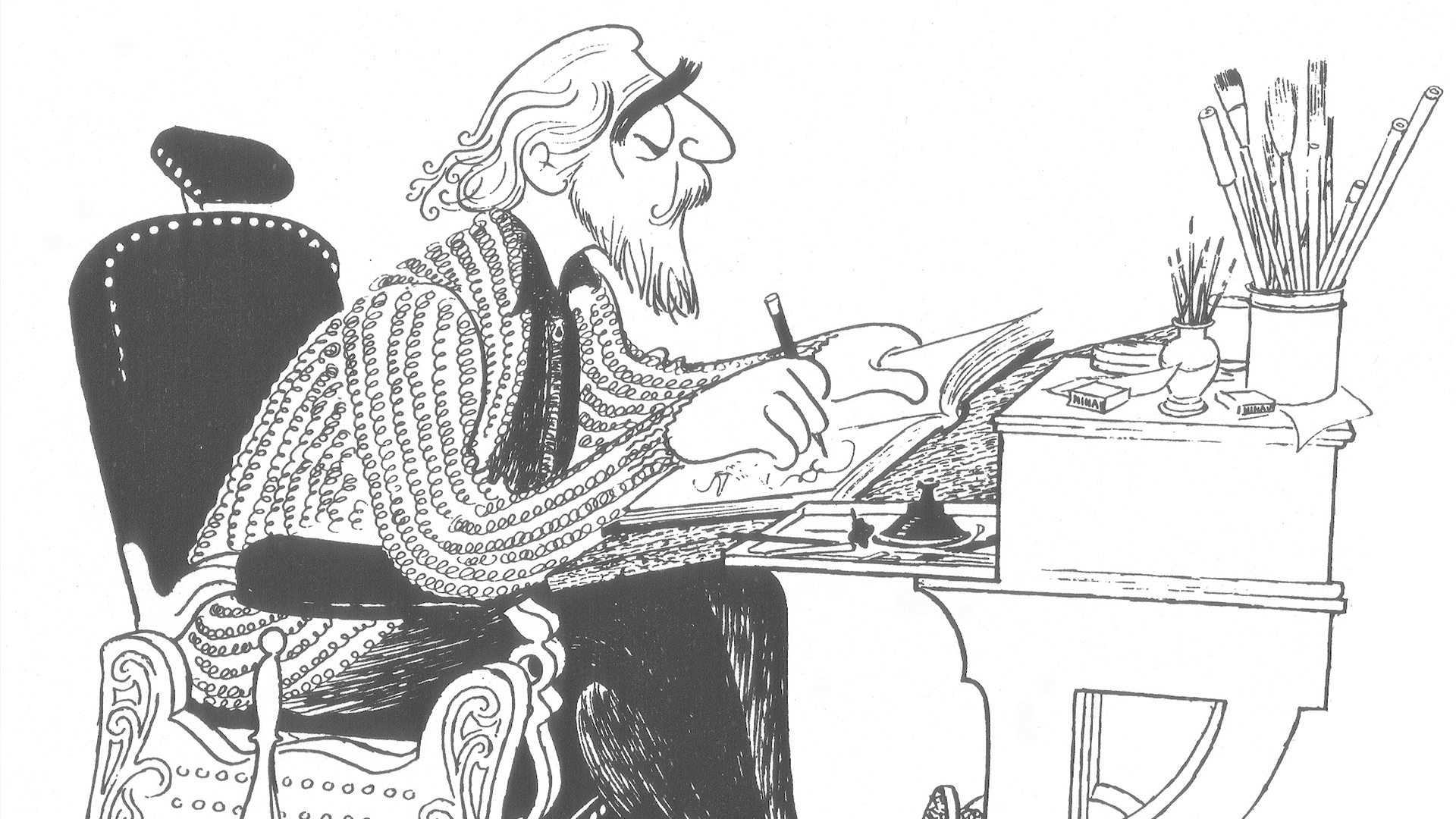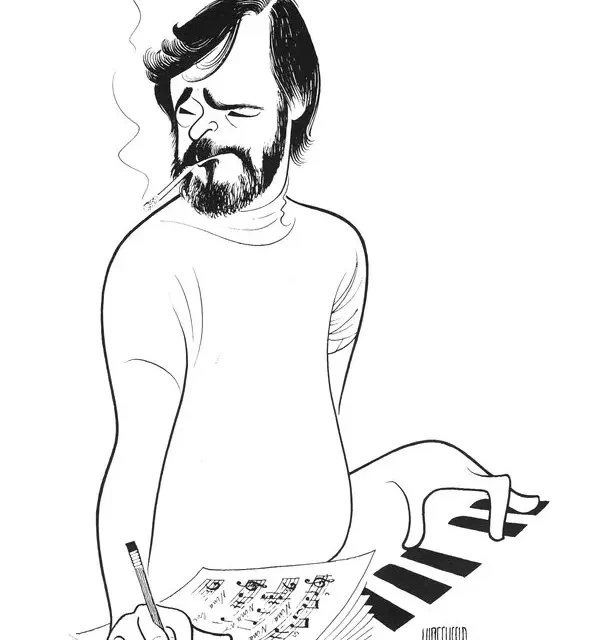By Ron Fassler . . .
“Hirschfeld drew from life. He was drawing from personal experience. He was going to the theatre and making sketches there and then coming back to his studio and putting it all together into a great drawing. But he was always working from life and that’s what’s also so amazing about Hirschfeld’s Sondheim. Imagine if I told you, ‘Hey, I’m going to give you a contemporaneous account by a guy who saw all the Sondheim shows, drew them from life, and had a knowledge of everything that happened before and after these shows?’ It would be an amazing thing, but that’s literally what this book is.”
– David Leopold, Creative Director of The Al Hirschfeld Foundation
As author of the new book Hirschfeld’s Sondheim, David Leopold recently shared his depth of knowledge with Theater Pizzazz on all things Hirschfeld, the master artist who chronicled the entertainment world for nearly nine decades. From his start in the film industry around 1920 until his death in 2003, Hirschfeld’s caricatures (and hidden Nina’s, the name of his only child cleverly concealed in anything from a pleated skirt to a bow tie) inspired generations of artists and nursed the dreams of millions of theatre lovers. Did you know that back in 1939, Hirschfeld did the advertising artwork for The Wizard of Oz? Or that he drew more covers for TV Guide than any other artist? Perhaps not, as what springs to mind first is his astounding career in the theatre. Consider that over the span of seven decades, he saw more Broadway shows than almost anyone and visually reported on them. Many during their out-of-town engagements, trying out in cities like Boston, Philadelphia, Detroit and New Haven.
Now, courtesy of the Al Hirschfeld Foundation, of which David Leopold is archivist and creative director, there is the soon-to-be published Hirschfeld’s Sondheim, due September 9th. It’s packed with drawings; some you might never have seen before. For example, if you think Anyone Can Whistle, the Sondheim-Arthur Laurents musical that only ran a week on Broadway, passed through town too quickly for Hirschfeld, think again. He saw it in Philadelphia and a drawing featuring Angela Lansbury, Lee Remick, and Harry Guardino will be on display:
Included in the book are Hirschfeld’s take on almost every Broadway musical and revue to which Sondheim contributed in his lifetime (Frogs is an exception, but hasn’t it always been?). The book is a joy and a treasure and with an introduction from Sondheim muse Bernadette Peters and a foreword by the former chief critic for the New York Times Ben Brantley, there is some beautiful prose to read in addition to Leopold’s cogent commentary.
In chatting with Leopold, our conversation covered a good deal of territory. Here then are some highlights, condensed and edited for clarity:
Ron Fassler: What inspired you to take on this project of Sondheim drawings as a book?
David Leopold: Well, like everybody else, I’m a fan of his work, and when Sondheim died, we highlighted him at the Hirschfeld Foundation website as we usually do when someone of his stature passes. We call them “spotlights.” So, we put together a collection of Sondheim drawings Hirschfeld had done of him and his musicals over the years, and I was amazed that there were over fifty drawings. And it really captured Sondheim’s career, intertwined as it was with Hirschfeld’s. There were no new Sondheim productions produced on Broadway that Hirschfeld did not draw during Sondheim’s life. So, the idea for a book was born right after he died. It took a while, but we finally got it right and turned it into a poster book, Hirschfeld’s Sondheim. It’s one of two new books, the second will be Hirschfeld’s Icons.
RF: Few people realize how MUCH theatre Hirschfeld saw in his lifetime. Not only did he attend Broadway opening nights as a regular, but he flew to many cities and saw out of town tryouts that add up to seeing more performances than most critics. And he did that for seventy-five years.
DL: You need to remember that when Hirschfeld first started going to the theatre in the early 1920s, it was only a step up from vaudeville. Frivolous musicals and that sort of thing. Then he sees the development of American drama and he’s there for Broadway’s Golden Age. He also sees the post-Golden age when musicals remade themselves, like Fiddler on the Roof and Cabaret. Then by the 1970s, Broadway’s looking back and Hirschfeld’s not. Revivals started to populate Broadway for the first time. He had seen the original No, No, Nanette and people were asking him about it, and he had no interest in it. He actually hired me to think about it.

RF: What were Hirschfeld’s takes on Sondheim? Did he appreciate the forward-thinking aspect of his musicals?
DL: Well, I visited him in his studio at least once a week for thirteen years and we talked about art and theatre pretty much exclusively. And we talked about a lot of things, but of course, in the twenty years since his passing I’m like, “Why didn’t I ask him about this?” or “I should have asked him about this.” Sondheim was a going concern while I was with Hirschfeld. I remember discussing Bounce with him, though it never reached Broadway and he didn’t draw it. I wish I had asked him more about his thinking on Sondheim. I do regret that now.
RF: Do you recall any assignments that stymied or frustrated him? Were there any artists that, despite how many times he drew them, he felt he failed them in some way?
DL: I remember one time, and this is sort of Sondheim related, but there was going to be a record coming out of all the Rodgers and Hammerstein performances on The Ed Sullivan Show. And I brought the assignment up to him and we chatted about it. I came by a couple of days later, and he asked me if I had any other pictures of Oscar Hammerstein. I said, “Sure, I can get you other pictures, but why do you need them?” And he said to me that every time he drew Hammerstein, he looked drunk. He had told me he’d done hundreds of drawings of him, and he couldn’t understand why they always turned out that way. So, I brought him some more photos, and he came up with a great drawing. He spent a long time on it, and it caused him a lot of angst . . . It’s important to remember that Hirschfeld was always drawing from life. He was drawing from personal experience.
RF: Are there drawings in this collection that will surprise even long-time fans of Hirschfeld’s work?
DL: Yes, there are a couple that have never been seen before. There’s a drawing of Sondheim, Jerome Kern and George Gershwin that’s never been published. Somebody commissioned it (a civilian, as we say here), but it’s in the archive and I was like, “We have to publish this.” We also publish a number of drawings Hirschfeld drew for the New York Times Friday column over a fourteen-year period. The cast drawings look kind of bloated compared to these because he’s working in this tiny space and he takes even more details he doesn’t need out of it. So, these drawings are so exquisite and wonderful.

I should add that this book of Hirschfeld’s work is the biggest one ever published.
RF: And there’s going to be a display of Hirschfelds coming up at the Algonquin Hotel’s Oak Room in September. Can you tell us a little bit about what we can expect to see up on the walls?
DL: There’ll be a special Sondheim section in the show that’s going to include the original drawing of Do I Hear a Waltz? which is stunning to see in person. It’s going to include both Sondheim portraits; the 1977 one is a Hirschfeld hand-signed, limited edition original lithograph and the 1999 one is only one of four prints made that Sondheim signed. It came out of a project with Broadway Cares and the Al Hirschfeld Foundation and I remember that at the first meeting we discussed how great would it be if we could get Sondheim to sign a portrait that no one had ever seen. He really was the white whale. As it turned out, Sondheim was a Hirschfeld collector. And when we approached him, he said, “I don’t usually do this. I’ll do it, but I’ll only sign four and I get to keep one.” So, there were only three out there and two were sold for a LOT of money and the last one we kept. It was used at exhibitions, like one at the Museum of Broadway. But since Hirschfeld left the artwork to the Foundation to support our activities, we looked at this and said we should sell this now so we can continue on our mission, which is to promote theatre and promote performing arts organizations, which is what we’re doing.
The Sondheim section coming up at the Algonquin is great. We have Gypsy, Funny Thing Happened on the Way to the Forum, Passion . . . And we also have incredible drawings and prints of other things and other shows. We’ve got a drawing of Phantom of the Opera that no one’s ever seen before. A drawing of Redheadwith Gwen Verdon. Everyone should come.
Hirschfeld’s Sondheim is available beginning September 9th at bookstores everywhere. “Strokes of Genius: Hirschfeld at the Algonquin” will be on exhibition in the hotel’s legendary Oak Room, September 9-20th, daily from noon to 7pm. For more information, please visit: https://www.alhirschfeldfoundation.org/exhibitions
All art courtesy of the Al Hirschfeld Foundation.


